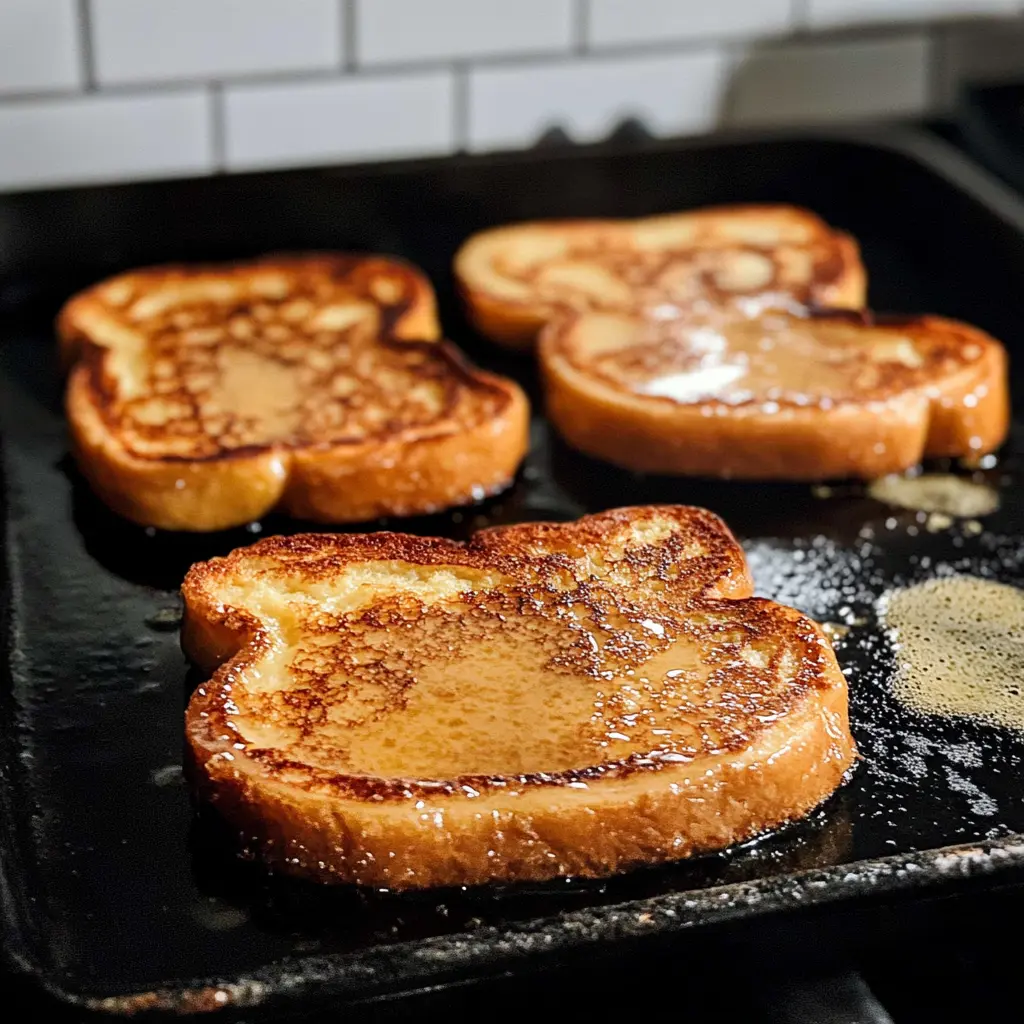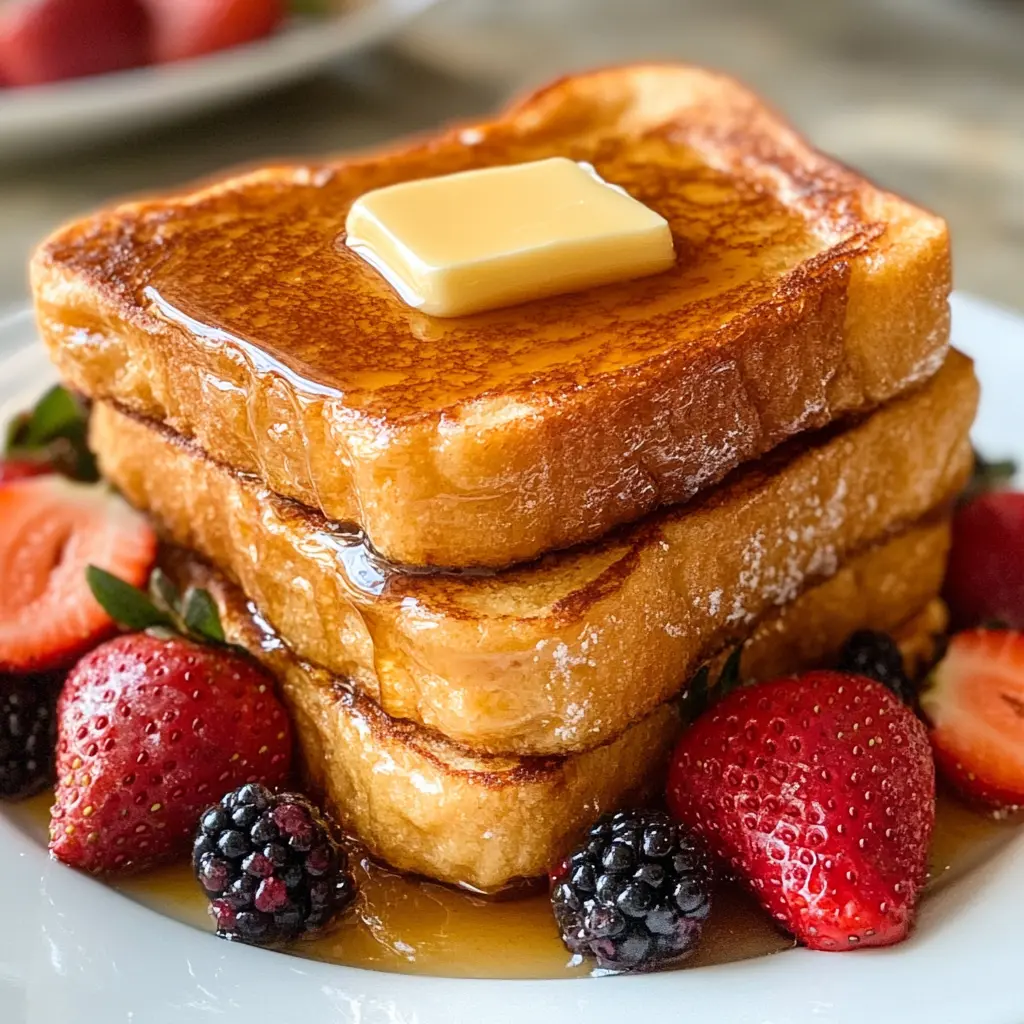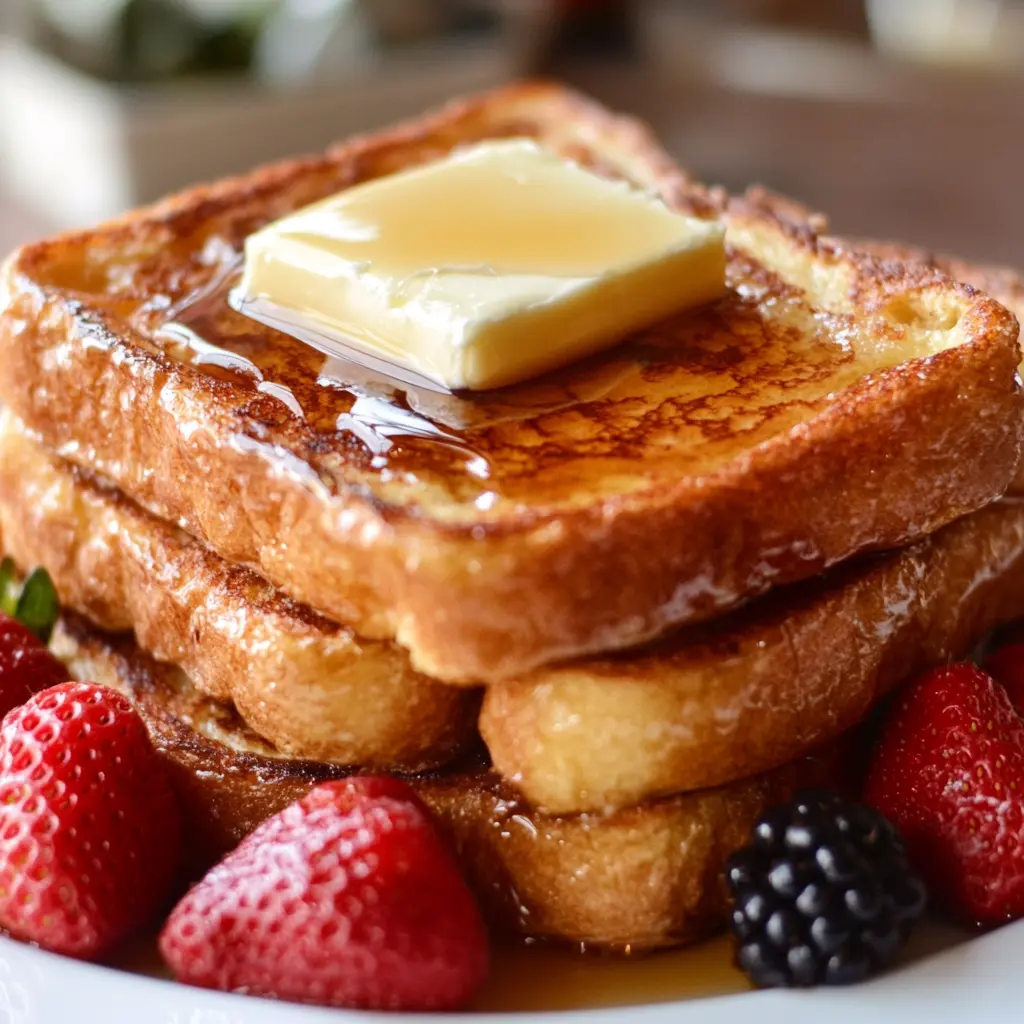Is French Toast Healthy? Discover Nutritional Insights
Introduction to Is French toast healthy
French toast, a beloved breakfast staple, traces its origins back to ancient Rome. Known as “pan dulcis”, this early version was made by soaking bread in a milk and egg mixture before frying it. Over the centuries, variations of French toast emerged across cultures, each adding their unique twist. In France, it’s called “pain perdu” or “lost bread,” highlighting its purpose of repurposing stale bread. Meanwhile, Americans often indulge in this dish as a sweet breakfast treat or even a comforting dessert.
Today, French toast’s popularity spans the globe, with countless variations incorporating diverse ingredients and toppings. From simple recipes using just bread, eggs, and milk, to elaborate versions featuring stuffed bread or gourmet toppings, French toast has firmly established itself as a versatile and cherished dish. This article delves into the nutritional aspects of French toast, exploring whether it can be part of a healthy diet and how to make it more nutritious. For those curious about other beloved comfort foods, explore the ingredients and recipes for mac and cheese.
Why People Love French Toast
French toast’s widespread appeal lies in its status as a comfort food. The crispy exterior, soft and warm interior, and sweet or savory toppings create a delightful eating experience that many find irresistible. Its versatility further enhances its allure; you can customize French toast with an array of ingredients like fruits, nuts, syrups, or spices, catering to a wide range of tastes and preferences. Whether it’s a quick weekday breakfast or a leisurely weekend brunch, French toast fits the bill, offering both convenience and indulgence.
Moreover, French toast’s simplicity makes it an easy dish to prepare at home, yet it’s elegant enough to serve at a special breakfast or brunch gathering. This combination of ease, versatility, and nostalgic comfort explains why French toast remains a favorite in many households around the world. If you’re looking to elevate your comfort food repertoire, consider making mac and cheese as a main course.
Nutritional Overview
Basic Ingredients of French Toast
French toast’s deliciousness stems from its simple yet rich ingredients. The traditional recipe includes bread, eggs, milk, sugar, and spices. Each ingredient contributes uniquely to the dish’s flavor and nutritional profile.
- Bread: Typically, white bread is used, but whole grain or gluten-free options can add more nutrients and fiber. A slice of white bread contains about 70 calories, 2 grams of protein, and 1 gram of fat.
- Eggs: Eggs are crucial for the batter, providing a good source of protein, healthy fats, and essential vitamins like B12 and D. One large egg offers roughly 70 calories, 6 grams of protein, and 5 grams of fat.
- Milk: Milk adds creaminess and enhances the nutritional value with calcium, vitamin D, and additional protein. A cup of whole milk has about 150 calories, 8 grams of protein, and 8 grams of fat.
- Sugar: Often used to sweeten the batter or as a topping, sugar increases the calorie count. A tablespoon of sugar has approximately 50 calories.
- Spices: Cinnamon, vanilla, and nutmeg are common spices that enhance flavor without adding significant calories.
By analyzing these components, we can see how French toast’s nutritional content varies based on the ingredients used. For a deeper understanding of nutrition in other comfort foods, check out Nutrition in Mac and Cheese: Facts & Tips.
| Ingredient | Calories | Protein (g) | Fat (g) | Carbs (g) |
|---|---|---|---|---|
| White Bread (1 slice) | 70 | 2 | 1 | 13 |
| Eggs (2 large) | 140 | 12 | 10 | 1 |
| Whole Milk (1/2 cup) | 75 | 4 | 4 | 6 |
| Sugar (1 tbsp) | 50 | 0 | 0 | 13 |
| Total | 335 | 18 | 15 | 33 |
Caloric Content of French Toast
The average caloric content of French toast can range from 200 to 400 calories per serving, depending on the ingredients and portion size. This variation allows for flexibility in fitting it into different dietary needs.
Comparison with Other Breakfast Options:
- French Toast: Approximately 300 calories per serving.
- Pancakes: Roughly 350 calories for a stack of three, without syrup.
- Omelet: About 200 calories for a two-egg omelet with vegetables.
Understanding the caloric content helps in making informed dietary choices. For insights into how caloric content impacts other popular dishes, explore Is Panera Mac and Cheese Healthy? Analyzing Nutritional Content.
Macronutrient Breakdown
French toast provides a balanced mix of carbohydrates, proteins, and fats:
- Carbohydrates: Primarily sourced from the bread and sugar, carbohydrates offer a quick energy boost. They are essential for fueling the brain and muscles.
- Proteins: Eggs and milk contribute the majority of the protein content, crucial for muscle repair and growth. Proteins also play a significant role in maintaining skin, hair, and overall body health.
- Fats: Found in eggs, milk, and possibly butter or oil used in cooking, fats are vital for brain function, hormone production, and absorbing fat-soluble vitamins.
Here’s a detailed macronutrient breakdown for a typical serving of French toast:
| Nutrient | Amount | Daily Value Contribution |
|---|---|---|
| Carbohydrates | 33 g | 11% |
| Proteins | 18 g | 36% |
| Fats | 15 g | 23% |
This macronutrient profile shows how French toast can fit into a balanced diet. For more comprehensive nutritional guides on comfort foods, visit Kraft Mac and Cheese Nutrition: Comprehensive Guide.
Health Benefits and Is French toast healthy
Protein and Energy Boost
French toast can be a potent source of protein and energy, making it an ideal choice for a hearty breakfast. The primary sources of protein in French toast are the eggs and milk used in the batter.
- Eggs: Eggs are a powerhouse of protein, with two large eggs contributing around 12 grams of high-quality protein. This protein is essential for muscle repair and growth, as well as for maintaining healthy skin and hair. Additionally, eggs contain all nine essential amino acids, making them a complete protein source.
- Milk: Milk adds another layer of protein to the mix, with half a cup providing approximately 4 grams. It also contributes essential nutrients like calcium and vitamin D, which are crucial for bone health.
The combination of these ingredients makes French toast an energy-dense meal. The carbohydrates from the bread provide a quick energy boost, while the protein and fats ensure sustained energy release throughout the morning. This balance helps maintain blood sugar levels and keeps you feeling full longer. For more ideas on protein-rich comfort foods, check out Protein with Mac and Cheese: Best Pairings and Tips.
Source of Essential Vitamins and Minerals
French toast is not just about protein and energy; it also packs a variety of essential vitamins and minerals, thanks to its diverse ingredients.
- Vitamins: Eggs and milk are rich in vitamins such as B12, D, and A. Vitamin B12 is vital for nerve function and the production of DNA and red blood cells. Vitamin D aids in calcium absorption and supports immune function, while vitamin A is crucial for vision and skin health.
- Minerals: French toast ingredients contribute several important minerals. Calcium from milk is essential for strong bones and teeth, and iron from eggs supports oxygen transport in the blood. Bread, especially whole grain, adds dietary fiber, which is important for digestive health.
Here’s a table summarizing the key vitamins and minerals found in a typical serving of French toast:
| Nutrient | Source | Benefits |
|---|---|---|
| Vitamin B12 | Eggs, milk | Nerve function, DNA production, red blood cell formation |
| Vitamin D | Milk, eggs | Calcium absorption, immune support |
| Vitamin A | Eggs | Vision, skin health |
| Calcium | Milk | Bone and teeth strength |
| Iron | Eggs, bread | Oxygen transport |
| Dietary Fiber | Whole grain bread | Digestive health |

Including these nutrients in your diet can significantly benefit overall health, making French toast a nutritionally valuable option when prepared with wholesome ingredients. To understand more about the nutritional value of dairy products, visit Are Cheeses Gluten-Free? Unveiling Dairy Facts.
Potential Health Concerns
High Sugar and Caloric Content
While French toast can be a delicious and nutritious breakfast option, traditional recipes often contain high sugar content, which can pose health concerns. Typically, sugar is added to the egg mixture or used as a topping, and combined with syrups and sugary fruits, this can significantly increase the dish’s calorie count.
- Sugar Content: A standard French toast recipe can include several tablespoons of sugar, each adding around 50 calories. When combined with syrup or powdered sugar, the sugar content can become quite high, potentially leading to increased blood sugar levels and a higher risk of developing diabetes if consumed frequently.
- Caloric Implications: With added sugars and rich ingredients like whole milk and butter, French toast can easily reach or exceed 400 calories per serving. For those managing their weight, consuming high-calorie breakfasts regularly can make it challenging to maintain a balanced diet and meet weight loss goals.
Understanding the calorie and sugar content is crucial for making healthier choices. For insights into how calorie-dense foods impact health, explore Is Kraft Mac and Cheese Healthy? A Complete Guide.
Use of Refined Carbohydrates
The type of bread used in French toast also impacts its nutritional value. Traditional recipes often call for white bread, which is a refined carbohydrate.
- Impact of White Bread: White bread is made from refined flour that has been stripped of most of its fiber and nutrients during processing. Consuming refined carbohydrates can lead to rapid spikes in blood sugar levels and provide little nutritional benefit beyond calories. Additionally, refined carbs are digested quickly, which can result in hunger soon after eating and potentially lead to overeating throughout the day.
- Healthier Alternatives: To boost the nutritional value of French toast, consider using whole grain or gluten-free bread. Whole grain bread contains more fiber, which aids in digestion and helps maintain steady blood sugar levels. It also provides more vitamins and minerals compared to white bread. Gluten-free bread is an excellent option for those with gluten sensitivities or celiac disease.
By choosing healthier bread options, you can make your French toast more nutritious without sacrificing taste. For more ideas on incorporating healthy ingredients, visit What to Mix in Mac and Cheese: Best Ingredients Guide.
| Bread Type | Fiber (g) | Nutrients |
|---|---|---|
| White Bread | 0.6 | Low in fiber and nutrients |
| Whole Grain Bread | 2-3 | High in fiber, vitamins, minerals |
| Gluten-Free Bread | 1-2 | Suitable for gluten-sensitive individuals |
Part 5: Making Healthier French Toast
Choosing Healthier Ingredients
Making French toast healthier starts with selecting the right ingredients. Opting for whole grain bread, low-fat milk, and natural sweeteners can significantly enhance the nutritional value of this beloved dish.
- Whole Grain Bread: Whole grain bread is a better choice than white bread as it contains more fiber, vitamins, and minerals. Fiber aids digestion, helps maintain stable blood sugar levels, and keeps you full longer.
- Low-Fat Milk: Using low-fat or skim milk instead of whole milk reduces the fat content while still providing essential nutrients like calcium and protein.
- Natural Sweeteners: Instead of refined sugar, consider natural sweeteners like honey, maple syrup, or stevia. These options can lower the glycemic index of your meal and provide additional nutrients and antioxidants.
Additionally, using organic and fresh ingredients can improve the overall quality and taste of your French toast. Organic eggs and milk often contain higher levels of omega-3 fatty acids and antioxidants, while fresh, local bread can be richer in flavor and nutrients. For more insights on gluten-free alternatives, explore Gluten-Free Mac and Cheese: Does it Taste Different?.
| Ingredient | Traditional Option | Healthier Alternative |
|---|---|---|
| Bread | White bread | Whole grain or gluten-free bread |
| Milk | Whole milk | Low-fat or skim milk |
| Sweetener | Refined sugar | Honey, maple syrup, or stevia |
| Eggs | Conventional eggs | Organic eggs |
Healthy Cooking Methods
How you cook French toast can also impact its healthiness. Here are some tips for healthier cooking methods:
- Baking vs. Frying: Baking French toast is a healthier alternative to frying. It requires less oil, which reduces the overall fat content. Simply arrange the soaked bread slices on a baking sheet and bake at 350°F (175°C) for about 20-25 minutes, turning halfway through.
- Using Non-Stick Pans: If you prefer frying, use a non-stick pan to minimize the need for oil or butter. A light spray of cooking oil or a small amount of healthier oils, like olive or coconut oil, can also be used.
- Minimal Oil: When using oil, opt for heart-healthy options and use them sparingly to keep the calorie count low.
These methods not only make French toast healthier but also maintain its delicious taste and texture. For more tips on maintaining the creamy texture of comfort foods, check out How to Keep Mac and Cheese Creamy: Ultimate Guide.

Conclusion
Summarizing Health Aspects of French Toast
French toast, when prepared with mindful ingredient choices and healthier cooking methods, can be a delicious and nutritious breakfast option. Balancing indulgence with nutritional awareness allows you to enjoy this comfort food while maintaining a healthy diet. By opting for whole grain bread, low-fat milk, and natural sweeteners, and by baking instead of frying, you can significantly improve its nutritional profile.
Ultimately, French toast can be part of a healthy lifestyle if consumed in moderation and paired with other nutrient-dense foods. Enjoying French toast healthily involves being creative with ingredients and mindful of portion sizes. For more healthy French toast recipes, stay inspired and keep experimenting in your kitchen.
FAQs
Is French toast good for weight loss?
French toast can be part of a weight loss diet if prepared with healthier ingredients and controlled portions. Using whole grain bread, low-fat milk, and minimal sugar can make it a more weight-friendly option. However, it’s essential to be mindful of the overall calorie content and avoid excessive toppings like syrup and butter. For more insights into balancing comfort foods and weight loss, check out Is Mac and Cheese Healthy? Analyzing Nutritional Impact.
Can French toast be part of a balanced diet?
Yes, French toast can be included in a balanced diet when made with nutritious ingredients. Opt for whole grain bread, organic eggs, and natural sweeteners to enhance its nutritional value. Balance it with a side of fresh fruits or a serving of yogurt for a complete and satisfying meal. To understand how to include various foods in a balanced diet, see Is Panera Mac and Cheese Healthy? Analyzing Nutritional Content.
What are the best toppings for healthy French toast?
Healthy toppings for French toast include fresh fruits like berries, bananas, and apples. Nuts, seeds, and a drizzle of honey or pure maple syrup can add flavor and nutrients without excessive calories. These toppings not only enhance taste but also add essential vitamins and minerals. For more topping ideas, explore What is Good on Mac and Cheese: Best Toppings and Mix-Ins.
How can I reduce the sugar content in French toast?
To reduce sugar content, use natural sweeteners like stevia, monk fruit, or a small amount of honey. Additionally, flavor the batter with spices such as cinnamon or nutmeg, which can provide sweetness without adding sugar. For more low-sugar breakfast ideas, visit Low-Sugar Breakfast Recipes.
Is French toast suitable for people with dietary restrictions?
French toast can be adapted for various dietary restrictions. For those who are gluten intolerant, use gluten-free bread. Vegans can substitute eggs with flax or chia seeds mixed with water and use plant-based milk. These substitutions ensure everyone can enjoy this delicious breakfast. For more inclusive breakfast ideas, see Vegan and Gluten-Free Breakfast Ideas.



